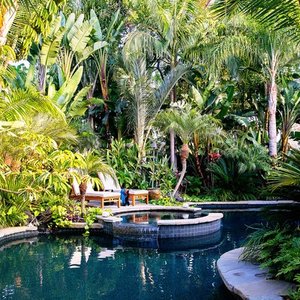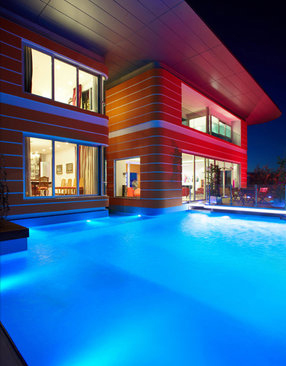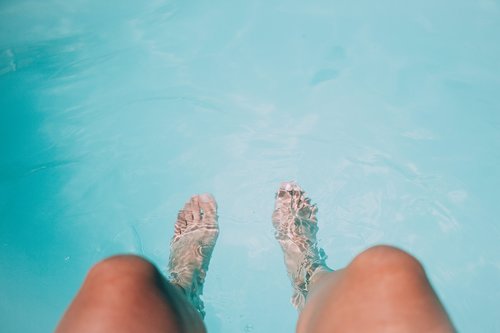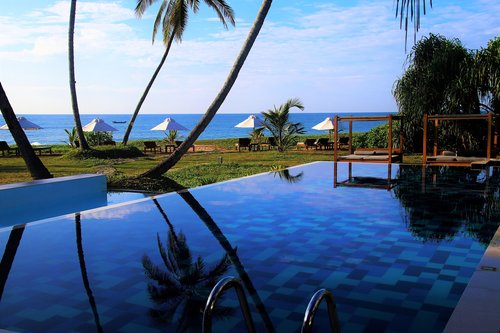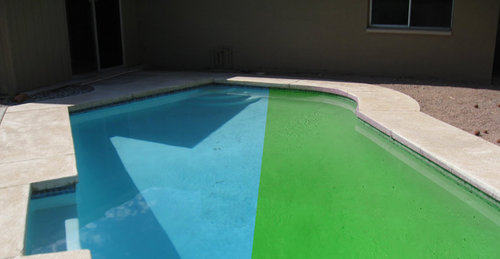According to the Sacramento Municipal Utility District, during the summer season a typical backyard California pool can use enough energy to power an entire home for three months.
It’s a good reason to maintain and operate your pool – or your spa – at peak efficiency.
Because pools or spas can use so much water and energy, the steps you take to conserve will benefit the environment and save you money on your utility bill – even while you continue to enjoy that backyard swim.
These tips can help you save energy, water and the money you spend on utility bills. Many of these are from the California Swimming Pool Industry Energy Conservation Task Force, a consortium of pool builders, pool technicians and retailers.
Ways to Save Energy in Your Pool
The pump and pool filter pump can be one of the largest users of electrical energy in a home. If you reduce the amount of time you run the pump, you’ll save energy and money.
Of course, the amount of time you’ll have to run your pool filter will vary according to the size of the pool, how much it’s used, and factors such as leaves or dirt that can blow into the water. A rule of thumb, however, says that all the water in the pool should be filtered once every 24 hours.
Consider the pool filter operating recommendations established by the California Swimming Pool Industry Energy Conservation Task Force:
“Reduce filter operating times to no less than 4 to 5 hours per day during the summer and 2 to 3 hours per day during the winter period. This will reduce annual electrical consumption by 40 to 50 percent. Normal and heavier swimming use may require as much as eight or more hours filtration per day. Should water clarity or chemical imbalance indicate inadequate filtration, immediately operate the filter until acceptable water clarity has again been established.
If additional filtration is still indicated, increase filter operating time in one-half hour increments until the water remains clear and properly balanced chemically. When the pool is being heavily used, it is recommended that the pool be operated manually and that the filtration system be run under such conditions. Under no circumstances should the water quality of any swimming pool be so poor that the main drain cover is not clearly visible from the deck.”
Consider a Time Clock
An automatic time clock for your filter and cleaning system is one of the smartest investments you can make. With it, you can avoid the electric power “rush” hour by not running your pool or spa filter on hot summer afternoons when demand for electricity is at its highest. Generally, peak demand hours are from 1 p.m. to 9 p.m., in the months from June through September, when most people are running air conditioning and other appliances.
By operating your pool pump during off-peak hours, you help reduce the demand on the State’s electrical system, postponing the need to construct new power plants and helping to keep electricity rates low for everyone. You’ll also help to prevent the sort of peak hour electrical emergencies that plagued California in the summer of 2000, when record-setting electrical use on consecutive, hot summer afternoons threatened the State’s power grid with occasional rolling blackouts. More directly, if you’re buying electricity at a time-of-use rate, avoiding electricity use during peak hours can lower your electric bill.
Once you determine the number of hours required for one complete filtering cycle of your pool water, set your filter prompt time clock for that much time, during off-peak hours.
Do Regular Preventive Maintenance
You’ll save money and energy if you keep your pool pump and filter operating as they are supposed to do. Follow a regular program of preventive maintenance and backwash or clean the filter as recommended by the manufacturer to maintain maximum efficiency. Be aware that some filters automatically backwash more frequently than they need to, and some designs don’t even need to be backwashed at all. Check the manual for the right regimen for your system.
Remove any foreign materials from the strainer baskets in the pump and skimmer regularly, to make sure the flow of water isn’t hampered.
Use Automatic Pool Cleaners
If your pool is equipped with an automatic pool sweep, operate it for three to four hours a day during the summer and two to three hours a day in the winter. Start the pool sweep 15 minutes or more after the filter pump is running and stop it 15 or more minutes before the filter pump stops. On unusually dusty days, increase cleaning time by half-hour increments until the pool is clean. Use a wall brush and leaf skimmer frequently to help the cleaner along.
Cover It Up
A good pool cover will save energy and water. It can keep the water in your pool an average of 10 degrees warmer, which can cut summertime pool heating costs by up to 90 percent! A cover reduces water and chemical evaporation by up to 70 percent, saving nearly a thousand gallons of water per month. A cover also helps keep your pool clean, which means you’ll have to run your filter pump less often, saving even more energy.
Heat Your Pool Efficiently
In addition to a pool cover, there are other ways to help keep the cost of heating your pool to a minimum while you still enjoy a comfortable water temperature.
First, make use of solar energy by locating your pool in the sunniest part of your yard. If possible, screen it from the cooling, prevailing wind with existing structures such as the house or garage, or add a solidly built fence as a windbreak.
Remember that over-hanging tree limbs create cooling shade. Trees also can shed leaves and twigs into the pool, while grass planted too close to the pool can send cuttings into the water. Such debris can clog or damage the filter, will make the filtering system much less efficient, and will require the use of additional pool chemicals.
Heat It With the Sun
You may want to consider solar heating for your pool. A solar unit, used in conjunction with a back-up heating system, can save on heating costs.
It typically costs between $2,000 and $4,000 to install a solar heater for a backyard pool. From the savings over the cost of an average fossil fuel heater, a solar pool heater should pay for itself in one-and-a-half to seven years, depending on your climate and the geographic location of the pool. Your actual cost will also depend on such factors as the ease of installation, type of financing you choose, the length of pool season, and local building code requirements.
It’s easy to understand how a solar heating system works if you’ve ever tried to drink out of a garden hose that’s been lying in the sun. When you first turn on the faucet, hot water comes out. The sun’s energy was absorbed by the hose and transmitted as heat to the water inside it. The hose acts as a solar collector.
Heating a pool to a comfortable swimming temperature uses relatively large amounts of energy. In the simplest, most common design, the pool’s filtration system pumps pool water through solar collectors – basically, a network of black plastic hoses. The pool itself serves as the system’s storage tank.
Solar collectors for swimming pools can also be flexible rubber mats or even tube-on-sheet panels made of copper or aluminum. They are generally not as involved as solar water heaters made for domestic use, which must heat water to much higher temperatures.
Ideally, swimming pool solar panels should be oriented toward the south. Most are mounted on the roof, though they can also be installed on patio covers, trellises or even on the ground.
The system must be sized properly – if there are too few solar panels, the pool’s water won’t get warm enough. To provide adequate heating, the total area of the solar panels should be somewhere between 50 percent to 80 percent of the pool’s surface area. The right size for a particular swimming pool depends on such factors as the pool’s capacity, the orientation of the panels to the sun, and the climate in which you live.
The most efficient solar systems use automatic controls – working like a thermostat – to set the temperature of the water in the pool. They direct water through the solar panels when the sun is out and the water is cool. When the water is warm enough, the controls shut off the flow of water through panels, preventing overheating in the hottest part of the summer.
Saving Water Saves Energy
Pumping and treating water, and then cleaning it up in waste water plants after it’s used, accounts for approximately 50 percent of a city’s energy bill. That’s why conserving water in California also saves energy.
Swimming pools are not necessarily water wasters. It may surprise you to learn that, under some conditions, swimming pools and irrigated lawns use approximately the same amount of water on a square-foot basis. In other words, if a homeowner were to remove a section of grass and install a swimming pool, the water use for each square foot of grass replaced by the pool’s surface would be approximately the same.
This estimate, which comes from the California Urban Water Conservation Council, relies on several assumptions – it figures evaporation from a pool in a warm summer climate like California’s Central Valley. This loss of water in the pool is compared against the evapotranspiration rate of grass, coupled with a lack of efficiency in the typical lawn watering system, which is only 30 to 50 percent efficient.
Swimming pools come out even better in this comparison of water-use, however, if you consider that decks or concrete walks usually ring a pool, displacing additional grass area. Depending on the landscape’s design, a backyard with an irrigated lawn can use more than one to one-and-a-half times as much water as the entire pool area – particularly if the homeowner is using an automatic timed sprinkler system.
We mentioned that using a pool cover will help you to conserve nearly a thousand gallons of water a month. Here are other ways to use less water in your pool.
- Ask swimmers to reduce splashing.
- Channel splashed-out pool water into landscaping.
- Lower pool water to reduce amount of water splashed out.
- Plug the overflow line when the pool is not in use.
- Use a broom, not a hose, when you are cleaning around the pool.
And, finally, some safety suggestions
- Always keep safety in mind when thinking about the use of energy around your pool.
- Beware of electric wires overhead when using a leaf skimmer.
- Be sure that electrical appliances used near the pool are grounded with weatherproof, grounded extension cords.
- Never touch electric wires, switches or appliances when you are wet, when you have wet hands or when you’re standing in water.
- Make use of low voltage wiring for all outdoor lighting needs around wet locations.
Saving Energy in Your SpaPortable spas are more energy efficient than in-the-ground spas, because they are better insulated and usually have covers.
If you have a typical portable spa, your heater will heat water 10 degrees in about 8 hours. If you use your spa once a week, lowering the temperature three degrees when not in use will save you approximately five percent to 10 percent of you spa heating costs; if you use the spa less often, your saving could be even greater.
Don’t run the jets unless you are using your spa. The mixture of water and air is great for relaxing the muscles, but it cools the water quickly.
Spa covers are important. Be sure to leave the cover on until you are ready to use your spa and replace when you’re finished. Remember that heat that escapes is the heat you must pay to replace.

